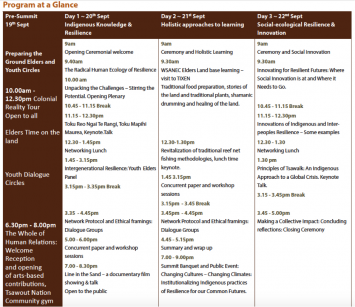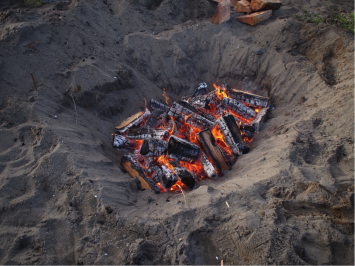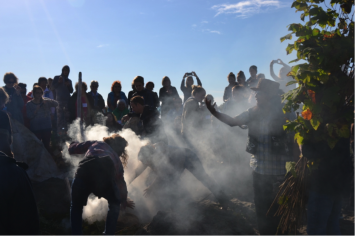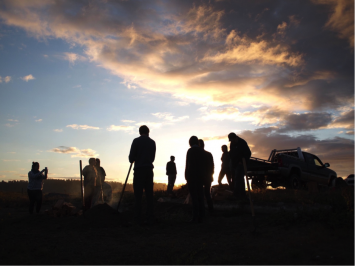 [1]
[1]An international group of young people preparing a traditional pit-fire on the lands of the Tsawout Nation during the Elders Voices Summit (photo – Robin Haig)
LINK: December 2017 General Issue: Curriculum and Change Table of Contents [2]
MacKinnon, Lewis, Waller, JSE 2017 General Issue PDF [3]
Having already crossed four of the nine planetary boundaries that are considered a safe operating space for humanity (Steffen et al., 2015), we now stand at the threshold of the Anthropocene epoch. The election of a president to govern the world’s largest economy who has withdrawn his country from the Paris Climate Accord – and who has appointed to key environmental governance positions non-scientists with contrarian views on critical ecological issues – surely moves us further from the point of safety (Milman, 2016).
This article explores the work of the Alliance for Intergenerational Resilience (AIR) as one practical proposal to change some of the underlying habits of thought and action that have led us towards the Anthropocene. Conceptually, resilience is now widely deployed in academic and policy discourse, increasingly in relation to challenges facing societies in times of resource scarcity and environmental attrition. As a concept ‘resilience’ emerged in natural science and as it enters and permeates social science disciplines, its meanings and epistemological assumptions are now being debated and, at times, fiercely contested (Brown, 2014; Ribot, 2014; Olsson, Galaz, & Boonstra, 2014). This is a wide-ranging debate and in our discussion in the next section we focus on ideas of community resilience.
In this article, we discuss the work of AIR to date and conclude with some thoughts about our ongoing and future directions. [AIR was first constituted in 2015 as the International Resilience Network (IRN) but has since changed its name to reflect the growing awareness among its directors that supporting intergenerational relationships will be central to the organization’s work. Some references in the bibliography will reflect the organization’s previous name.] In particular, we focus on the Alliance’s inaugural summit, a place-based sustainability forum held on Indigenous territory in Canada and intended to build relationships and shared understandings of social-ecological resilience across culturally diverse Indigenous and settler-migrant communities. We provide an outline and rationale of AIR’s approach to nurturing social-ecological resilience and the Alliance’s vision and goals before focusing on the processes, pedagogical approaches and outcomes of the Resilient Places – Resilient Peoples: Elders’ Voices Summit (hereafter named Elders’ Voices Summit). The section on the Summit will adopt the story-telling narrative style that was central to the Summit’s pedagogical approach and which is common to indigenous learning processes. It will also be supported by comments from delegates which were given in feedback forms following the Summit.
A rationale for indigenous and inter-cultural resilience
This section outlines the rationale for AIR’s work and develops upon the idea that some Indigenous and place-based communities hold forms of social-ecological resilience that may help to mitigate critical anthropogenic impacts on the global environment. It also questions the same proposal: if resilience can be found among particular communities, then what factors and processes may have caused it to be lost elsewhere; how can such resilience be recovered among communities where it has been lost? Additionally, the section explores connections between community resilience and the project to re-indigenize all people to the Earth.
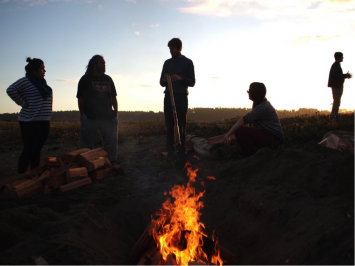 [4]
[4]Young people from Aotearoa and Alba/Scotland worked together to prepare the pit-fire (photo – Robin Haig)
The Elders’ Voices Summit took place on the lands of Tsawout Nation of Vancouver Island in September 2015. At the conclusion of the Summit, the Alliance was constituted as a collaboration of communities, organizations and individuals with the objective of building social-ecological resilience by connecting and supporting locally based projects for the innovative and renovative co-evolution of social and ecological systems in participating regions and countries. In particular, AIR aims to support the work of Indigenous communities that are maintaining and rebuilding connections to their home-places in order to continue and develop their distinctive ways of being in the world. It also aims to connect these groups with each other, and with organizations working for communities who are no longer indigenous to place but who desire more meaningful relationships in and with the lands on which they live now. Among the Alliance’s founding ideas is the view that cultural practices and principles of Indigenous peoples hold insights that can not only contribute to those peoples’ own ongoing struggles against colonizing powers, but can also contribute to the paradigmatic shift in worldview required if humanity is to maintain and develop forms of resilience needed to meet the unprecedented social and ecological challenges of the 21st century and life in the Anthropocene.
Kristen Magis (2010) has described community resilience as the “existence, development and engagement of community resources by community members to thrive in an environment characterized by change, uncertainty, unpredictability and surprise” (p. 401), a definition that builds on the early natural science focus on resilience as the ability of ecological systems to absorb changes in environmental conditions and persist (Hollings, 1973. p. 17. See also Walker et al, 2004). Some resilience scholarship has been critiqued for defining the term in ways that contain the presumption of resilience as a ‘good’. (See discussion in Olsson, Galaz, & Boonstra, 2014) This would certainly seem the case in Magis’ definition of community resilience with its telos to ‘thrive’. From a positivist or objectivist scientific position this normativity would be questionable. However, the apparent normativity in some definitions of resilience, including community resilience definitions, leaves open the possibility that resilience can be understood as an essentialist concept, bearing resemblance to the normative qualities of social and ecological relations described in some indigenous worldviews. Fikret Berkes and Helen Ross (2013; 2016), who have adopted Magis’ definition in their work on developing an integrated approach to community resilience within social ecological systems, specifically include Indigenous groups among those that exemplify community resilience. They argued (2013) that ‘Community resilience concepts apply best to place-based communities’ and to Indigenous communities, and that understanding ‘the values and behavior that bond communities and cultures with their environments’ is critical for understanding their resilience (p. 17).
A growing body of literature (Cajete, 2000; Deloria & Wildcat, 2001; Mitchell et al., 2008; Williams, Roberts & McIntosh, 2012) is presenting the argument that there is a central dynamic relationship of values and behaviour that exist between Indigenous peoples and the lands and waters that permeate their sense of place and of being. Speaking from the context of the Raramuri who live in what is today called northern Mexico, Enrique Salmón (2015) argues that place and the living and non-living things that constitute a place are not separate from the people of that place, but that as humans “we view ourselves as “integral” parts of our natural surroundings” (p. 3). Humans, he argues, are “part of an extended ecological family that shares ancestry and origins” (Salmón, 2000, p. 1332). He calls this a ‘kincentric ecology’. Knowledge derives from this extended sense of family rooted in place, and from this sense of family people learn and practice how to live. In this sense social-ecological resilience can be considered as an expression of what Battiste and Henderson (2000) call “the vibrant relationships between the people, their ecosystems, and the other living beings and spirits that share their lands” (p. 42) whose purpose is to ensure that to the best extent possible all our relations have what they need to thrive.
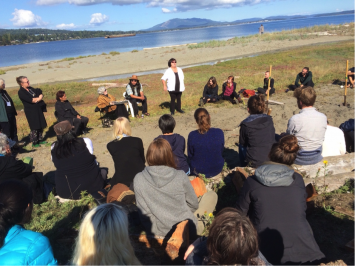 [5]
[5]Elder Belinda Claxton shares Tsawout traditional knowledge of place on TIXEN spit during the Elders’ Voices Summit (photo – Iain MacKinnon)
Maori scholar Makere Stewart-Harawira (2005) argues that the values and behavior involved in such relationships can be considered as the expressions of ‘indigenous ontologies’ that have “an important place in theories of social transformation”. In particular, she argues that the critical insights of ways in which Indigenous peoples “define their relationships to all other life forms and to the cosmos”, can contest the “ethno-centrism of conservative and liberalist approaches to globalization” that are deeply implicated in the emergence of the geological Anthropocene. While acknowledging the essentialist nature of such a project, Stewart-Harawira has proposed that it may be possible to realize “an indigenous ontology of being” (p. 19, 35). The contents of such an ontology would have the potential to inform a larger project of decolonization and reconciliation referred to as work “to re-indigenize ourselves to our common home, Mother Earth” by the co-founder of the Bioneers network, Kenny Ausubel, in his preface to ‘Original Instructions’—a collection of teachings and suggested solutions to today’s global crisis from Indigenous leaders and other visionaries (Ausubel, 2008, p. xxii). This is work to enable for all people a deep and reciprocal connection to the Earth and its inhabitants made up of places we can all call home. Indeed, Williams (2012) has argued that “every person on this planet has the innate capacity to be Indigenous” (p. 93). What is suggested here is that, by speaking up against ongoing experiences which do not conform to their relational norms, and by articulating the deep cultural values by which they maintain life, Indigenous peoples can offer vital inter-cultural contributions to necessary changes in the ways in which a much wider portion of humanity think about our relationships with the world and act upon it.
Critically, however, Indigenous scholars acknowledge that alongside community resilience and the maintenance of indigenous ontologies there also exists in Indigenous communities widespread alienation and the loss of ways of knowing and being. The Okanagan scholar and activist Jeannette Armstrong addressed this alienation and loss when, drawing on the work of a colleague, she proposed to the Elders’ Voices Summit (2015) that at present many of us are “out of our indigenous minds”. Such alienation – affecting our experiences of inner and outer worlds – is an intrinsic part of the colonial experience. It has been called ‘colonization of the mind’ by the Gĩkũyũ scholar and novelist Ngũgĩ W Wa Thiong’o (Wa Thiong’o, 1986. See also Tuhiwai Smith, 1999).
The existence of colonial alienation among Indigenous peoples means that although we do not disagree with Berkes and Ross’ claim that ‘community resilience concepts apply best to place-based communities’ and to Indigenous communities, we believe their claim necessitates a space within resilience theorizing for a more critical analysis of how communities lose their place-base, their sense of being indigenous to that place, and their ability – by way of that sense of being indigenous to place – to foster individual and collective resilience. Analysis of the strengths of resilient communities needs to be complemented with historical and political work assessing why resilience seems to ‘apply best to place-based communities’, and with enquiry into why some communities appear to be able to maintain and develop ‘adaptive capacities’ to shock and stress that other communities appear to lack. These are questions AIR seeks to address and the methodology of the Summit was designed with such questions in mind.
While seeking to open a way for an Earth-centred ontological project of indigenization, AIR recognizes that in its common contemporary usage, the term ‘indigenous’ has a specific history as part of a political project focused on a limited number of peoples. In international law the term ‘indigenous’ was used in the second half of the 20th century to articulate the rights of populations not formally decolonized during the process of dismantling the European powers’ overseas empires following World War Two and still affected by the legacy of imperialism. In the same period the word also began to be used as a form of resistance identity by some of those peoples (Rodríguez-Piñero, 2005; Stewart-Harawira, 2005, p. 114-144). In this sense indigenous politics is important ‘unfinished business’ (Wilmer, 1993, p. 5).
Because of the diversity of cultures and perspectives held by 370 million Indigenous Peoples throughout the world today, no one single definition has been arrived at by any United Nations body and even the UN Declaration on the Rights of Indigenous Peoples avoids any single definition. Rather a more loosely bounded set of characteristics has been proposed which include: self-identification; historical continuity with territory and/or pre-colonial societies; strong links to territory and surrounding natural resources; and, the resolve to maintain and reproduce their ancestral environments and systems as distinctive peoples and communities (UN Permanent Forum on Indigenous Issues, n.d.). The current use of ‘indigenous’ as a term describing the political struggles of a particular diverse group of peoples against the ongoing effects of colonialism also draws attention to the fact that an Earth-centred project of indigenization and re-indigenization does and will take place little-by-little, by way of culturally specific experiences in specific places. AIR’s approach reflects the localized nature of change, and the emphasis of Indigenous activists on the importance of Eldership, leadership and service (Kenny & Fraser, 2012). There is also an emphasis on participation, inter-cultural and inter-generational experiential and place-based learning, and arts-based methods which can help to bring place to life.
Elders’ Voices Summit
The elements of this approach were employed during the Elders’ Voices Summit which consisted of four days of Indigenous-led sustainability education and was attended by more than 100 people from Turtle Island [Canada and the United States], Aotearoa [New Zealand], Australia and Alba [Scotland], representing community, university, government, philanthropy and not-for-profit sectors. The age of attendees ranged from 17 to 80, reflecting the event’s focus on intergenerational resilience, and contained three broad, but overlapping, constituencies: Indigenous peoples colonized within their own homelands; settlers on Indigenous territories, usually of European origin, whose ancestors may have been colonized in their own territories prior to migration and who were then, after migration, complicit to varying degrees in the colonization of others; and more recent migrant peoples, often racialized and disenfranchised from homelands to which they are indigenous (Williams & Turner, 2015; Williams & Claxton, 2017). In consequence, the Summit brought together a range of assumptions, worldviews, ideas about agency and practical abilities into a space concerned with cultural and ecological action. Within the wider context of the AIR’s agenda, the Summit’s objectives were fourfold:
1. Relationship building among AIR members;
2. Identification of common and different perspectives relating to human and environmental well-being, and deepening participants’ understanding of the roots of these often diverse perspectives and agency imperatives;
3. Developing methodological and ethical frameworks to serve as the future basis for engaged research and innovation for socio-ecological resilience; and,
4. Refinement of key themes to ensure collaborator relevance and knowledge-mobilization of emergent insights and findings in relation to Summit themes (Williams & Turner, 2015)
As a means of realizing these objectives, inter-generational resilience was identified as a central theme for the Summit. It was interpreted by the organizers as “ensuring to the best extent possible that the next generations of human and other than human relations have what they need to flourish” (Williams & Claxton, 2016). Furthermore, the organizers framed the relationship between human and other than human nature on the basis of ‘kincentricity’, implying an understanding of intergenerational knowledge transmission as existing not only within but also between species; in this way the theme was able to draw together different strands of the Alliance’s cultural, ecological and disciplinary interests, which are often compartmentalized and considered unrelated.
Kincentricity was interwoven throughout the Summit’s four days as we progressed our way through the themes (roughly sequentially, but by no means linearly) of: 1) Preparing the Ground, 2) Indigenous Knowledge and Resilience, 3) Holistic Approaches to Learning, and 4) Innovations of Indigenous and Inter-people’s Resilience. (For a visual representation of the Summit program see figure 1.) While some days tended to emphasise more cultural re-mapping in narrative (E.g., indigenous knowledge and resilience) or epistemological terms (e.g. holistic, land-based learning) both elements were present on each day. All activities took place on either Tsawout or Saanich territory.
The Summit’s central strand of deepening delegates’ awareness of indigenous connections to place began on the pre-Summit day with a ‘colonial reality’ tour around the city of Victoria by Cheryl Bryce, a Lekwungen tradition-carrier. She works to reinstate and maintain native flora as part of a wider cross-generational, cross-community project to restore colonially disrupted pre-contact eco-systems around the city. Through her guidance, aspects of native history, food systems and cosmology emerged from within Victoria’s domesticated Beacon Hill city park and urbanized waterfront and river systems. She described how trophy-hunters had desecrated Lekwungen sacred sites, and the tour experience also indicated a wider cross-community societal desecration in Victoria today. At one quiet spot under a city bridge that spans a river important in the cosmology of Cheryl’s people’s there is an excavated shellfish midden, thousands of years old. It testified to a deep human presence in the place. As we were learning of the place’s cultural significance, just a few yards away a homeless man was sleeping next to a bin. While Indigenous people make up a vastly disproportionate percentage of Victoria’s homeless, it is a crisis that crosses cultural divides (Condon, 2016).
The vast external social-ecological changes within the Lekwungen territory that Cheryl Bryce described pointed to equally great shifts in native autonomy, connection to place and self-understanding – shifts that the philosopher Jonathon Lear has described as colonialism’s ability to generate ‘ontological vulnerability’ in colonized peoples (Lear, 2009). The consequences of this deep vulnerability were outlined by several Indigenous delegates during panel sessions, most notably by Haida Gwai elder, Barb Wilson (Kii’iljuus), who described the magnitude of population loss among her own west coast people – going from 12,000 to 500 in just a few years as a result of settler introduced diseases – and the catastrophic effects on those who survived (see Elders-Youth Panel, http://intergenresil.com/2015-summit/videos.html).
The centre-piece of the Summit was another moment of place-based learning: a morning ceremonial pit-fire on TIXEN, a spit of land on the east coast of the Saanich Peninsula in the south of Vancouver Island and an important locale in the Tsawout people’s traditional territory. For many generations TIXEN spit has been used for gathering traditional foods, collecting medicinal plants, preparing special meals, celebrations and spiritual reflection. Some of these traditions had been discarded but are now being recovered and, as part of the process of recovery, a small group of younger delegates to the Summit (including co-author MacKinnon from whose account of the pit-fire the following paragraphs are drawn) were given the privilege of participating in a ceremonial occasion which would help to maintain and transmit the pit-fire tradition.
Our small group of delegates from Canada, Aotearoa and Alba/Scotland arrived to TIXEN before the sun and, as light filled the day, things proceeded in a relaxed but effective way. We organised and divided ourselves for the tasks that came along. We dug a hole in the sand at the very top of the shore, roughly 4’x3’x2’. Then we covered the base of it with stones made of volcanic rock and filled the pit with pine and cedar wood to make a fire that would heat the stones. While the fire heated the stones, some of us travelled to the Tsawout’s sacred mountain to collect salal, a plant which we would use in the cooking. We travelled through their territory while the local men accompanying us shared local news and politics – each new view also brought a new question or a story. When we came to the mountain they found an area where salal was growing and we cut two large bunches of the leafy shrub. When we returned to the spit we found that others in our group had been gathering too – thimbleberry leaves and sword fern fronds, which would be used in the cooking.
Our group of a dozen or so were on the early shift to heat the stones ready for the food to be put into the pit, and around 0900 the rest of the Summit attendees joined us. For the next six hours or so the whole process of the Summit would unfold on the sands of TIXEN spit. A young native medicine man, JB Williams, guided the novices through our work. First we took out what was left of the burning logs from the pit. Then, on top of the hot stones, we began to add layers of the vegetation we had gathered. This would protect the food – potatoes, carrots and parsnips in muslin bags, and a salmon on a platter made of reeds. The food was layered into the pit with the vegetation we had gathered. JB explained that the vegetation would also add sweetness and flavor to our food. A long thick stick had been placed upright in the base of the pit and the vegetation and food added around it.
Once the layers had been added, we poured plenty of water down the stick where it would meet the hot rocks and steam the food. Then we covered the food, vegetation, water and stones over with a piece of canvas, and put sand over the top. After doing this, there was still a couple of little puffs of steam escaping so we added extra sand on them to stop the steam and the heat from coming out.
For the next three hours, as seabirds wheeled and cried above us and Tsawout tradition carriers shared stories that conveyed aspects of traditional knowledge from plant-lore to origin-stories, our lunch cooked beneath us in the sand. With each story, the tradition carriers stressed, there is a message and a meaning to guide good conduct. But they also told us about the loss of tradition; the loss of plant knowledge and other forms of traditional knowledge; the loss of language. They praised one settler Canadian academic in particular whose dedication to documenting and supporting the revitalization and transmission of native plant knowledge and foodways had changed many attitudes among a generation of the Tsawout people who had been taught by colonialism that their traditions were irrelevant and worthy only of being discarded. When we dug up our lunch and ate it, we gave thanks to the Creator who had provided our sustenance. This remarkable session provided the Tsawout with an opportunity to share some of their unique contribution to planetary social-ecological resilience, and delegates were able to experience the cultural ground of a resurgent people recovering their own sense of resilience.
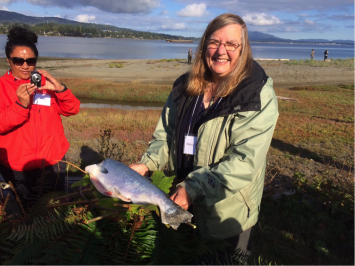 [9]
[9]The distinguished ethnobotanist Professor Nancy Turner holds a platter she made with local plants on which the salmon was steamed in the pit-fire (photo – Iain MacKinnon)
Several delegates commented on the power of these two place-based sessions, with one concluding: ‘I was particularly impacted by the colonial reality tour and Land-based Learning – these practice-based sessions led by Aboriginal leaders gave a concrete experience of place from First Nations’ perspective through stories told on sites of cultural importance. Being there and hearing and seeing these has far more impact than reading a book or hearing this on a panel.’ Another delegate, a Maori, expressed the view that hearing the stories of Lekwungen acted as an affirmation for her of the senselessness of the abuse that the Maori had also suffered under colonialism. With regard to the pit-fire, several delegates commented along the lines that it was ‘a good way to connect’ with one saying that ‘watching the various groups of people talking to each other in that open environment’ during the visit to the spit took ‘the official frame off of the gathering in some way and create[d] opportunity for connection’. Another said the way the way the pit-fire session was held enabled them to feel ‘the synergies of the [Tsawout’s] land and water flow through me’. (Williams & Turner, 2015) The power and importance of the place based session was a consistent response but the learning methods used in these, and other, sessions were also repeatedly referred to in terms of being ‘especially rich and meaningful’, typical comment being: ‘Song, art, and story are necessary and valuable means of knowledge-sharing and capacity building, side-lined by Western epistemological paradigms’.
The place-based experiences were complemented with other forms of learning. The first evening of the Summit saw presentations on three arts-based projects which focused on cross-cultural exchange and healing. These promoted South American weaving, a sharing of Maori and Scottish sense-of-place through film, and young artists responding to the experiences of survivors of Canada’s residential school system. This session sought to ensure that a focus on deepening inter-cultural understanding and cultural and ecological healing would be integral to the Summit.
The first full day began with an invitation from the Alliance’s founding director Lewis Williams for the Summit to proceed in a way that embodied the forms of relationship and relational thinking that its methodology sought to bring into being, namely that of an expanded kincentric conception of the human person and of a person’s relationship to the world. In her plenary the Radical Human Ecology of Resilience (http://intergenresil.com/2015-summit/videos.html ), she drew on some of the many strands of the ecological crisis, relating to the ways in which human beings in Western societies are recursively embedded in an economic system of extraction and extinction which itself conditions the way that many of us have come to think about the nature of our world, and to act on that conception.
Within this way of thinking, the material world is privileged, she said.
We begin, somehow, habitually to think that the material world becomes larger than life and…we forget that we are far more than material beings…but we are empathic, feeling, compassionate, human beings. We are not just rational actors going about out business. We are deeply interconnected. (Williams, 2015)
This invitation to let our participation at the Summit be informed by a deepening of humanity and human-ecological connection, was important in framing the gathering and enabling participants to engage fully with their ‘whole selves’ in the panels and presentations which followed. Focusing on means and methods to connect and reconnect to self, society and ecology in response to the sense of crisis, these included sessions with a focus on: the practice and recovery of traditional ecological knowledge for environmental restoration; new conceptions and modes of governing natural resources; cross-community relations; intergenerational resilience; the potential for social innovation and philanthropy to contribute to social-ecological resilience; and the role of migrant women in maintaining or recovering traditional culture and identity in new territorial contexts. A range of place-based projects for regeneration and resilience were shared from delegates from Alba/Scotland, Canada and Aotearoa and these were followed by a further plenary, this time on intergenerational resilience featuring Elders and youth.
This first day was full with content for thought and discussion, and so the following day on TIXEN enabled that rich content to be more fully digested in a context of a less formal learning, time to eat and walk in nature, and to hear the experiences of a community and a people gathering their own strength and their recovering resilience. The final day then saw a return to more presentational content, but with an emphasis on future-work. From these discussions, and from the post-summit feedback from participants, there is now a revised set of objectives for AIR to take forward.
Beyond the Summit
The experience of the Summit prompted a deepening of the experience of ‘what it is to be human’ for many who attended, including its organizers and those closest to it workings. Since the Summit, a few of us at the hub of AIR have been engaged in a process of shifting, sense-making and integrating the collective presence of this gathering, as seen, heard and felt. Just as the Summit was not a linear experience, neither has this sense-making been a neat and obviously logical process; as we have absorbed, taken space, discussed, and reflected on, and for some of us, carried the imprints of the place and space of gathering, back to our own ancestral territories. This alchemical reconstitution of being and group has its own pace and timing.
In the months following the Summit, Lewis Williams invited four others to join AIR’s central hub as co-directors: including co-author MacKinnon, another Indigenous academic from the University of Victoria, Canada, and two Indigenous youth representatives from Aotearoa and Alba/Scotland. Nurturing the relationships between us has been and continues to be an integral part of the resilience of AIR – just as we recognize the importance of kincentricity to our planet’s well-being, we are also aware of the importance of bringing this perspective to our relationships and future organizational thinking. This relationship building has made it possible for MacKinnon to stand down as a director but continue to work in a support and advisory role.
Collectively we have many aspirations for AIR! A five year vision for AIR’s future work – an Indigenous Social Impact Strategy (IRN, 2016) – and a Youth Concept Paper (Waller, 2016) have since been formulated. These articulate a number of objectives such as an interactive digital platform as a means of providing Elders, youth and other AIR affiliates the opportunity to continue to share ideas and perspectives; ongoing bi-annual in-person summits in different indigenous contexts; social-ecological innovation labs hosted by different Alliance nodes, and; supporting applied evaluation research at local levels on issues of human and ecological resilience in ways which connect and strengthen often isolated practice communities.
The abiding and interconnecting thread for AIR’s continuing development is our strategic priority of nurturing a kincentric understanding and practice of multi-generational resilience –embracing deep listening both inter-generationally between humans, and also between humans and our other than human relatives. Relatedly, just as we cast our net forward in a sense, so too do we cast it back, gathering up our pasts and bringing them with us. As put so eloquently by one young AIR co-director who is Maori:
For Maori – indeed all cultures – the integral questions of “ko wai au?” “Who am I?” and “No wai au?” “From whom do I come from” hold importance beyond a basic surface level. These questions are the cement of our collective existence, the foundations upon which we stand – they are our reason, our relevance and relationship. They are ultimately our right to be. (Waller, 2016, p. 1)
An important part of AIR’s future and our intergenerational or multi-generational work will be in time the formation of a youth chapter; an aspiration very clearly expressed by the young adults in the final plenary session of the Summit “Making a Collective Impact” (http://www.intergenresil.com 3.50 min). Building on the strong relationships forged and potent conversations about the kind of resilience needed to navigate now and in the future key younger AIR members are clear that just as learning from the Elders is critical, so too do the younger generations ‘have a lot offer in terms of being able to imagine new ways of being and belonging’. (Waller, 2016, p. 1)
The perspective articulated in the initial IRN Youth Plan (Waller, 2016) is now being taken forward and integrated into first of several key strategic priorities for AIR: ‘Strengthening and developing promising practices of multi-generational knowledge transmission within and between Indigenous, settler and recent-migrant communities; and the ongoing development of Elder and youth engagement in IRN’ (IRN, 2016, p. 5). Recently launched, this participatory and action orientated research continues to address the questions of agency and de-colonial praxis noted earlier in the article. Occurring in the seven Alliance nodes across Turtle Island, Alba/Scotland, and Oceana, these spaces of multi-generational conversation include the use of dialogue, arts-informed methods and the practical application of traditional knowledge to issues of social-ecological resilience. As well as having practical application, this strategic objective is intended to generate theory about meanings and practices of multi-generational resilience, towards the development of promising practices. Through the data collected this strategic priority will contribute to shaping the ethical framing and protocol for AIR; or put another way, our kincentric relational ethic for the work of AIR. It will ask questions such as: ‘How do Elders see the meaning and practice of resilience?’ and ‘How do these differ from youth perspectives?’
AIR’s first example of such a project is with the Tsawout First Nation which centers around Tsawout’s traditional ReefNet fishing which once sat at the heart of their social economy. Tsawout is one of five bands comprising the Saanich peoples (or in their SENĆOŦEN language, the WSÁNEĆ Nation) who over thousands of years have continuously occupied the Saanich Peninsula, on Southern Vancouver Island and surrounding Gulf Islands and San Juan Islands of the Salish Sea in the region now known as Southwest British Columbia Canada and Washington State. The ReefNet fishing is focused around catching salmon – an integral part of the Tsawout People’s diet that also has deep spiritual and cultural significance. In the WSÁNEĆ People’s creation genealogy, like the plants, rocks, elements and animals, the salmon were once people, and are considered relatives (Williams & Claxton, 2016). Thus, there are practices built into the ReefNet fishing that ensure its sustainability such as a cessation of all fishing activities for up to four days at the peak of the salmon run allowing the salmon to sustain their lineages. Banned in 1916 by the colonial government, one of AIR’s co-directors, (Nick Claxton) has been working with his people to restore these traditional methods (Burgmman, 2015). Among ReefNet fishing sustainability attributes are that it results in no wasted unwanted by-catch and burns no fossil fuels.
Launched at a public event in early August 2017 called “To Fish as Formerly: ReefNet Fishing and Reconciliation” (see http://www.intergenresil.com ) AIR’s first multi-generational resilience project (strategic priority one) centres around the WSANEC traditional ReefNet fishing methods. Its aims are to: a) promote intergenerational knowledge transmission of traditional ReefNet fishing methods and relationship building between Tsawout Elders and youth, and, b) promote intercultural understanding of the historical significance of WSANEC ReefNet fishing methods to the Tsawout social economy, the impacts of its banning by the colonial government, and the broader social-ecological benefits of this means of fishing to Indigenous and settler society more generally. Not only do we hope to learn more about and contribute to strengthening promising practices of intergenerational resilience within Tsawout, we hope that the sharing of these processes and experiences by Tsawout band members with the wider public will also lead to a cross-fertilization of knowledge and practice between cultural groups as well as considerations regarding how to enable traditional methods of ReefNet fishing to influence mainstream fishing.
*
The JSE editorial called for visionary work to “transcend these entrenched group identities that are ripping at the fabric of humanity”. AIR’s work seeks to raise awareness that many of us have become denaturalized from a sense of belonging to, and caring for, a particular place on Earth as part of an ancient human presence there, and that, relatedly, we have been made subject to a mode for living that contributes to ripping up the protective natural fabrics of our planetary home. Rather than ‘going beyond’ our sense of belonging to a group, AIR’s work calls our human condition back to ‘re-cognizing’ and re-inhabiting our indigenous minds and the Earthly presence that encompasses and constitutes us, and to celebrate them/us in their/our diversity, necessity and goodness, as well as in their/our limits.
Such work seeks to transcend the contracted self-understanding promoted by an economic system that systematically diminishes the resilience of nature and human potential, but it seeks to do so by retaining and supporting the diversity of group identities from which social-ecological resilience can thrive. This looking within both for what we have been and for what what we have become is done in prospect of an immanent transformation in order to realize what we might yet become here on Earth. It is founded on the view that our diverse, necessary and good group identities here on Earth now also constitute membership of a common Indigenous humanity that is itself deeply enmeshed with, dependent upon and part of the natural fabric of a living Earth. These sentiments are powerfully captured by the late Jeannette McCullough, a key force behind the previous work of AIR, who led a session on shamanic drumming at the Summit, in one of her comments on the event:
‘We can hold our identity and beneath that find our common ground’.
References
AP [Associated Press]. (2016, September 29). Global warming will hit critical levels in just 35 years, scientists warn as they hit out at politicians celebrating Paris agreement. Daily Mail. Retrieved from: http://www.dailymail.co.uk/sciencetech/article-3814172/Scientists-World-likely-wont-avoid-dangerous-warming-mark.html
Armstrong, J. (2015). Some thoughts on indigeneity. Unpacking the Challenges, Stirring the Potential Panel. Presentation at the Resilient Places – Resilient Peoples: Elders’ Voices Summit Sept 20th 2015. Retrieved from http://eldersvoicessummit.com/videos.html
Ausubel, K. (2008). Preface: Remembering the Original Instructions. In M.K. Nelson (Ed.) Original Instructions: Indigenous teachings for a sustainable future (pp. xxi-xxiii). Rochester, Vermont: Bear and Company.
Battiste, M. & Youngblood Henderson, J.S. (2000). Protecting Indigenous knowledge and heritage. Saskatoon: Purich Press.
Berkes, F., Colding, J., & Folke C. (2003). Introduction. In F. Berkes, J. Colding, & C. Folke (Eds.), Navigating social-ecological systems. Building resilience for complexity and change (pp. 1-30). Cambridge: Cambridge University Press.
Berkes, F. & Ross, H. (2013). Community resilience: Toward an integrated approach. Society & Natural Resources, 26(1), pp. 5-20, DOI: 10.1080/08941920.2012.736605
Berkes, F. & Ross, H. (2016). Panarchy and Community Resilience: Sustainability science and policy implications. Environmental Science and Policy 61 pp. 185-193. DOI: http://dx.doi.org/10.1016/j.envsci.2016.04.004
Brown, K. (2014), Global Environmental Change 1: A Social Turn for Resilience. Progress in Human Geography 38(1), pp. 107–117.
Burgmann, T. (2015, August 9). Traditional Fishing Methods Revival Launched by First Nations Man. CBC News British Columbia, Retrieved from: http://www.cbc.ca/news/canada/british-columbia/traditional-fishing-revival-launched-by-first-nations-man-1.3184856
Cajete, G. (2000). Native science: Natural laws of interdependence. Sante Fe, New Mexico: Clear Light Publishers.
Condon, S. (2016, June 8). Victoria homeless count shows shocking results. Megaphone Magazine. Retrieved from: http://www.megaphonemagazine.com/victoria_homeless_count_shows_shocking_results
Deloria, V. and Wildcat, D. (2001). Power and place: Indian education in America. Golden, Colorado: Fulcrum Publishers.
Holling, C. S. (1973). Resilience and stability of ecological systems. Annual Review of Ecological Systems 4 pp. 1-23.
IRN. (2016). Moving Forward. International Resilience Network. An Indigenous Social Impact Strategy. Unpublished.
Kenny C., & Fraser, T.F. (Eds.). (2012). Living Indigenous Leadership. Native narratives on building strong communities. Vancouver: UBC Press.
Lear, J. (2009). Radical hope: Ethics in the Face of Cultural Devastation. Cambridge, Massachusetts: Harvard University Press.
Magis, K. (2010). Community Resilience: an Indicator of Social Sustainability. Society and Natural Resources 23(5) pp. 401-416. DOI: http://dx.doi.org/10.1080/08941920903305674
Milman, O. (2016, December 12). Trump’s transition: skeptics guide every agency dealing with climate change. The Guardian. Retrieved from: https://www.theguardian.com/us-news/2016/dec/12/donald-trump-environment-climate-change-skeptics
Mitchell, H., Vizina, Y., Augustus, C., & Sawyer, J. (2008). Learning Indigenous science from place. Research study examining Indigenous-based science perspectives in Saskatchewan First Nations and Métis Community Contexts. Saskatoon: University of Saskatchewan. Retrieved from: http://aerc.usask.ca/downloads/Learning-Indigenous-Science-From-Place.pdf
Olsson, P., Galaz, V., and Boonstra W. J. (2014). Sustainability transformations: a resilience perspective. Ecology and Society 19(4), pp. 1. DOI: http://dx.doi.org/10.5751/ES-06799-190401
Ribot, J. (2014). Cause and response: vulnerability and climate in the Anthropocene. The Journal of Peasant Studies, 41(5), pp. 667-705, DOI: 10.1080/03066150.2014.894911
Rodríguez-Piñero, L. (2005). Indigenous Peoples, postcolonialism, and international law. The ILO regime (1919-1989). Oxford: Oxford University Press.
Salmón, E. (2000). Kincentric ecology: Indigenous perceptions of the human-nature relationship. Ecological Applications 10(5), pp. 1327-1332.
Salmón, E. (2015). Teaching kincentric ecology in an urban environment. Journal of Sustainability Education. Vol. 10, November.
Steffen, W., Richardson, K., Rockström, J., Cornell, S.E., Fetzer, I., Bennett, E.M., Biggs, R., Carpenter, S.R., de Vries, W., de Wit, C.A., Folke, C., Gerten, D., Heinke, J., Mace, G.M., Persson, L.M., Ramanathan, V., Reyers, B., Sörlin, S. (2015). Planetary boundaries: Guiding human development on a changing planet. Science 347 (6223)
Stewart-Harawira, M. (2005). The New Imperial Order. Indigenous Responses to Globalization. Wellington: Huia Publishers.
Tuhiwai Smith, L. (1999). Decolonizing methodologies. Research and Indigenous Peoples. Dunedin: University of Otago Press.
UN Permanent Forum on Indigenous Issues. (n.d.). Indigenous Peoples, Indigenous voices. Fact sheet. Retrieved from: www.un.org/esa/socdev/unpfii/documents/5session_factsheet1.pdf
Walker, B., Holling, C. S., Carpenter, S. R. and Kinzig. A. (2004). Resilience, Adaptability and Transformability in Social-Ecological Systems. Ecology and Society 9(2) 5.
Waller, A. (2016). International Resilience Network – Youth contribution to IRN. Unpublished paper.
Wa Thiong’o, N. (1986). Decolonizing the mind: The politics of language in African literature. London: James Currey.
Watson, R., Carraro, C., Canziani, P., Nakicenovic, N., McCarthy, J.J., Goldemberg, J., Hisas, L. (2016). The truth about climate change. FEU-US: Buenos Aires. Retrieved from: http://feu-us.org/wp-content/uploads/2016/09/The-Truth-About-Climate-Change.pdf
Williams, L. (2012). The human ecologist as alchemist: An inquiry into Ngai Te Rangi cosmology, human agency and well-being in a time of ecological peril. In L. Williams, L., Roberts, R. and A. McIntosh (Eds.), Radical human ecology: Intercultural and Indigenous approaches. (pp.91-120). Farnham: Ashgate Publishing Group.
Williams, L. (2015). Radical human ecology of resilience. Presentation at the Resilient Places – Resilient Peoples: Elders’ Voices Summit Sept 20th 2015. Retrieved from
http://intergenresil.com/2015-summit/videos.html
L. Williams, R. Roberts, & A. McIntosh (Eds.). (2012). Radical human ecology: Intercultural and Indigenous approaches. Farnham: Ashgate Publishing Group.
Williams, L. and Turner, N. (2015). Resilient Places – Resilient Peoples: Elders’ Voices Summit 2015. Evaluation report. Victoria, Canada: International Resilience Network. Retrieved from http://www.intergenresil.com
Williams, L., & Claxton, N. (2017). Recultivating Intergenerational Resilience: Possibilities for Scaling DEEP through Disruptive Pedagogies of Decolonization and Reconciliation. Under Review with Canadian Journal of Environmental Education, 22, 60-81 https://cjee.lakeheadu.ca
Wilmer, F. (1993). The Indigenous voice in world politics. Thousand Oaks, California: SAGE Publications.
Wolfe, P. (2006) Settler colonialism and the elimination of the native. Journal of Genocide Research 8(4), pp. 387–409
